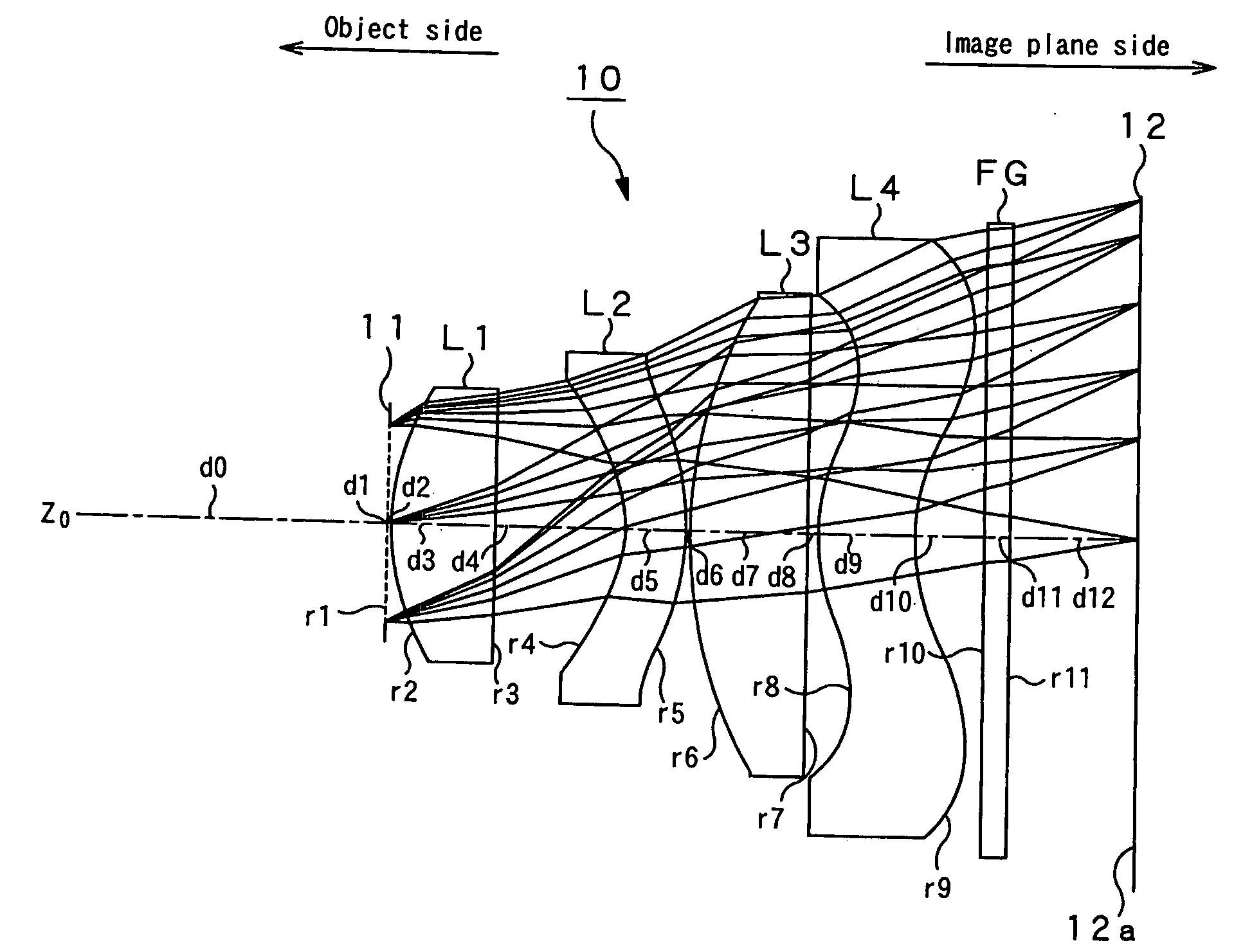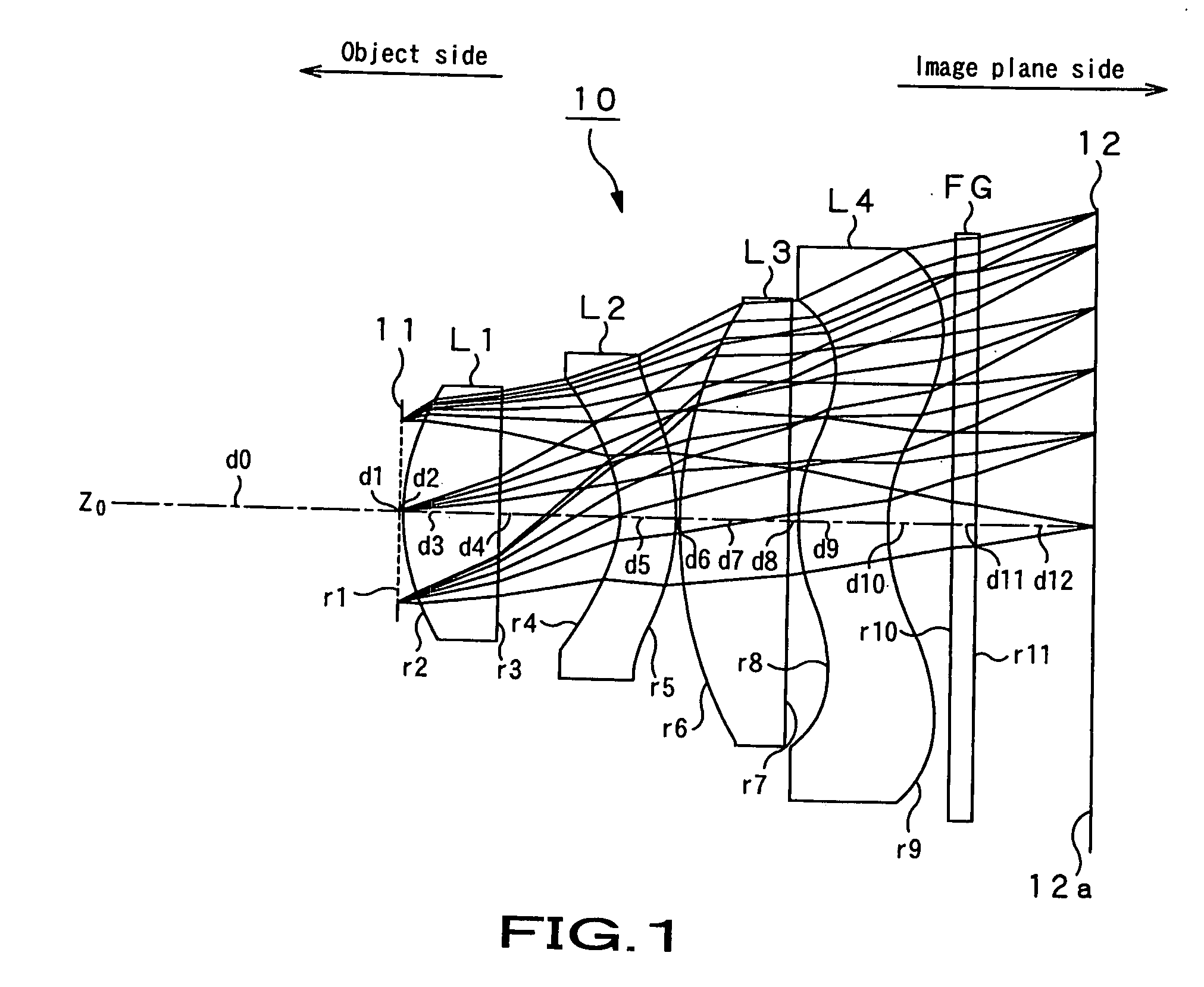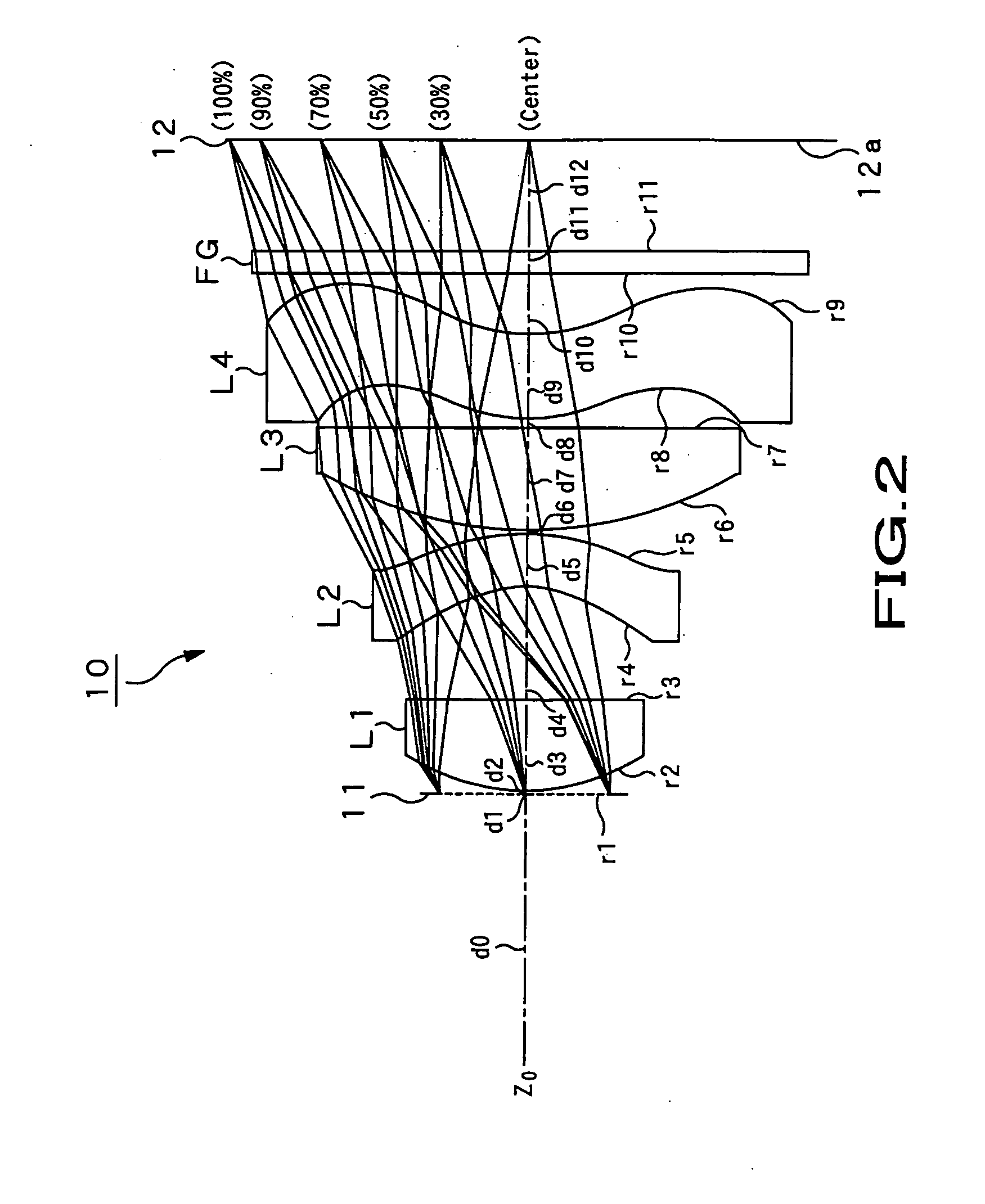Image pickup lens
a pickup element and image technology, applied in the field of image pickup elements, can solve the problems of more than 3 million pixels, difficult to enhance the image forming capability of a downsized low cost, and difficult to downsize an image pickup element having a high image forming capability at low cost, so as to achieve high moldability, reduce cost, and improve the effect of mass production and manufacturing cos
- Summary
- Abstract
- Description
- Claims
- Application Information
AI Technical Summary
Benefits of technology
Problems solved by technology
Method used
Image
Examples
example 1
[0068]FIG. 2 illustrates the image pickup lens 10 of Example 1. In FIG. 2, incident light fluxes that strike the image pickup lens 10 respectively at the center position (0.00 mm), at 30% image height position (1.05 mm), at 50% image height position (1.75 mm), at 70% image height position (2.45 mm), at 90% image height position (3.15 mm) and at 100% image height position (3.50 mm) are shown. Some of the design data of the image pickup lens 10 of Example 1 in FIG. 2 are shown in Table 2 below.
TABLE 2f = 5.74 mm FNo = 2.8 ω = 31.3°radius ofaxial inter-surfacesurface No.curvaturedistancefocalAbbe numberiRddistance fνd0∞20661∞2.05022.4502.85.8495.03∞2.84−1.451 3.0075−2.690 3.56165.0944.87110.2281.67∞5.00381.6545.01291.4666.13510 ∞6.37711 ∞6.46012(IMG)∞7.015
[0069] As shown in Table 2, the focal distance f of the entire optical system of the image pickup lens 10 of Example 1 is 5.74 mm and the F number FNo is 2.8, while the half view angle ω is 31.3°. It is also shown in FIG. 2 that t...
example 2
[0084]FIG. 9 illustrates the image pickup lens 10 of Example 2. In FIG. 9, incident light fluxes that strike the image pickup lens 10 respectively at the center position (0.00 mm), at 30% image height position (1.05 mm), at 50% image height position (1.75 mm), at 70% image height position (2.45 mm), at 90% image height position (3.15 mm) and at 100% image height position (3.50 mm) are shown. Some of the design data of the image pickup lens 10 of Example 2 in FIG. 9 are shown in Table 4 below.
TABLE 4f = 5.68 mm FNo = 2.8 ω = 31.53°surfaceradius ofaxial inter-surfaceNo.curvaturedistancefocalAbbe numberiRddistance Ndνd0∞20861∞2.03022.6422.85.8695.03−62.95 2.84−1.404 3.0255−2.693 3.60964.8444.8749.7281.67∞4.96281.5844.97091.4376.14410 ∞6.38711 ∞6.47012(IMG)∞7.024
[0085] As shown in Table 4, the focal distance f of the entire optical system of the image pickup lens 10 of Example 2 is 5.68 mm and the F number FNo is 2.8, while the half view angle ω is 31.53°. It is also shown in Table...
example 3
[0100]FIG. 16 illustrates the image pickup lens 10 of Example 3. In FIG. 16, incident light fluxes that strike the image pickup lens 10 respectively at the center position (0.00 mm), at 30% image height position (1.05 mm), at 50% image height position (1.75 mm), at 70% image height position (2.45 mm), at 90% image height position (3.15 mm) and at 100% image heightposition (3.50 mm) are shown. Some of the design data of the image pickup lens 10 of Example 3 in FIG. 16 are shown in Table 6 below.
TABLE 6f = 5.54 mm FNo = 2.8 ω = 32.2°radiusaxial inter-surfacefocalsurface No.of curvaturedistancedistanceAbbe numberiRdNdνd0∞21411∞1.97922.8682.85.75481.63∞2.84−1.432 2.9615−3.029 3.54164.6864.9279.4081.67∞5.02481.5885.07791.5836.0410 ∞6.32811 ∞6.41712(IMG)∞7.011
[0101] As shown in Table 6, the focal distance f of the entire optical system of the image pickup lens 10 of Example 3 is 5.78 mm and the F number FNo is 2.8, while the half view angle ω is 32.2°. It is also shown in Table 6 that...
PUM
 Login to View More
Login to View More Abstract
Description
Claims
Application Information
 Login to View More
Login to View More - R&D
- Intellectual Property
- Life Sciences
- Materials
- Tech Scout
- Unparalleled Data Quality
- Higher Quality Content
- 60% Fewer Hallucinations
Browse by: Latest US Patents, China's latest patents, Technical Efficacy Thesaurus, Application Domain, Technology Topic, Popular Technical Reports.
© 2025 PatSnap. All rights reserved.Legal|Privacy policy|Modern Slavery Act Transparency Statement|Sitemap|About US| Contact US: help@patsnap.com



